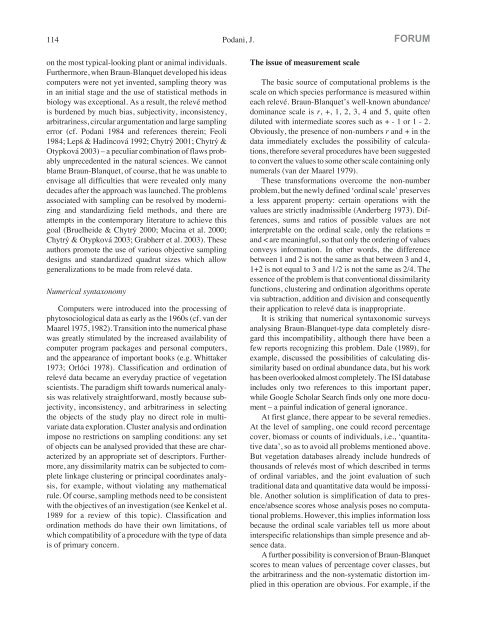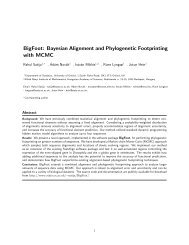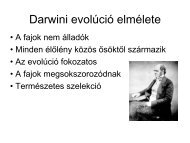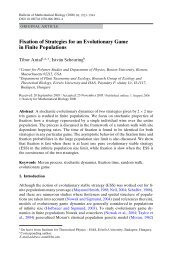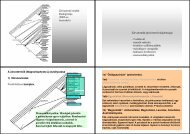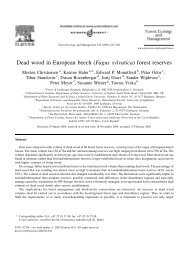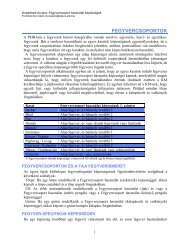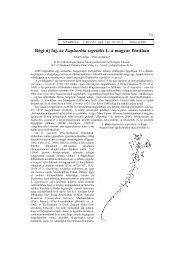Braun-Blanquet's legacy and data analysis in vegetation science
Braun-Blanquet's legacy and data analysis in vegetation science
Braun-Blanquet's legacy and data analysis in vegetation science
Create successful ePaper yourself
Turn your PDF publications into a flip-book with our unique Google optimized e-Paper software.
114 Podani, J. FORUM<br />
on the most typical-look<strong>in</strong>g plant or animal <strong>in</strong>dividuals.<br />
Furthermore, when <strong>Braun</strong>-Blanquet developed his ideas<br />
computers were not yet <strong>in</strong>vented, sampl<strong>in</strong>g theory was<br />
<strong>in</strong> an <strong>in</strong>itial stage <strong>and</strong> the use of statistical methods <strong>in</strong><br />
biology was exceptional. As a result, the relevé method<br />
is burdened by much bias, subjectivity, <strong>in</strong>consistency,<br />
arbitrar<strong>in</strong>ess, circular argumentation <strong>and</strong> large sampl<strong>in</strong>g<br />
error (cf. Podani 1984 <strong>and</strong> references there<strong>in</strong>; Feoli<br />
1984; Lepš & Had<strong>in</strong>cová 1992; Chytrý 2001; Chytrý &<br />
Otypková 2003) – a peculiar comb<strong>in</strong>ation of flaws probably<br />
unprecedented <strong>in</strong> the natural <strong>science</strong>s. We cannot<br />
blame <strong>Braun</strong>-Blanquet, of course, that he was unable to<br />
envisage all difficulties that were revealed only many<br />
decades after the approach was launched. The problems<br />
associated with sampl<strong>in</strong>g can be resolved by moderniz<strong>in</strong>g<br />
<strong>and</strong> st<strong>and</strong>ardiz<strong>in</strong>g field methods, <strong>and</strong> there are<br />
attempts <strong>in</strong> the contemporary literature to achieve this<br />
goal (Bruelheide & Chytrý 2000; Muc<strong>in</strong>a et al. 2000;<br />
Chytrý & Otypková 2003; Grabherr et al. 2003). These<br />
authors promote the use of various objective sampl<strong>in</strong>g<br />
designs <strong>and</strong> st<strong>and</strong>ardized quadrat sizes which allow<br />
generalizations to be made from relevé <strong>data</strong>.<br />
Numerical syntaxonomy<br />
Computers were <strong>in</strong>troduced <strong>in</strong>to the process<strong>in</strong>g of<br />
phytosociological <strong>data</strong> as early as the 1960s (cf. van der<br />
Maarel 1975, 1982). Transition <strong>in</strong>to the numerical phase<br />
was greatly stimulated by the <strong>in</strong>creased availability of<br />
computer program packages <strong>and</strong> personal computers,<br />
<strong>and</strong> the appearance of important books (e.g. Whittaker<br />
1973; Orlóci 1978). Classification <strong>and</strong> ord<strong>in</strong>ation of<br />
relevé <strong>data</strong> became an everyday practice of <strong>vegetation</strong><br />
scientists. The paradigm shift towards numerical <strong>analysis</strong><br />
was relatively straightforward, mostly because subjectivity,<br />
<strong>in</strong>consistency, <strong>and</strong> arbitrar<strong>in</strong>ess <strong>in</strong> select<strong>in</strong>g<br />
the objects of the study play no direct role <strong>in</strong> multivariate<br />
<strong>data</strong> exploration. Cluster <strong>analysis</strong> <strong>and</strong> ord<strong>in</strong>ation<br />
impose no restrictions on sampl<strong>in</strong>g conditions: any set<br />
of objects can be analysed provided that these are characterized<br />
by an appropriate set of descriptors. Furthermore,<br />
any dissimilarity matrix can be subjected to complete<br />
l<strong>in</strong>kage cluster<strong>in</strong>g or pr<strong>in</strong>cipal coord<strong>in</strong>ates <strong>analysis</strong>,<br />
for example, without violat<strong>in</strong>g any mathematical<br />
rule. Of course, sampl<strong>in</strong>g methods need to be consistent<br />
with the objectives of an <strong>in</strong>vestigation (see Kenkel et al.<br />
1989 for a review of this topic). Classification <strong>and</strong><br />
ord<strong>in</strong>ation methods do have their own limitations, of<br />
which compatibility of a procedure with the type of <strong>data</strong><br />
is of primary concern.<br />
The issue of measurement scale<br />
The basic source of computational problems is the<br />
scale on which species performance is measured with<strong>in</strong><br />
each relevé. <strong>Braun</strong>-Blanquet’s well-known abundance/<br />
dom<strong>in</strong>ance scale is r, +, 1, 2, 3, 4 <strong>and</strong> 5, quite often<br />
diluted with <strong>in</strong>termediate scores such as + - 1 or 1 - 2.<br />
Obviously, the presence of non-numbers r <strong>and</strong> + <strong>in</strong> the<br />
<strong>data</strong> immediately excludes the possibility of calculations,<br />
therefore several procedures have been suggested<br />
to convert the values to some other scale conta<strong>in</strong><strong>in</strong>g only<br />
numerals (van der Maarel 1979).<br />
These transformations overcome the non-number<br />
problem, but the newly def<strong>in</strong>ed ‘ord<strong>in</strong>al scale’ preserves<br />
a less apparent property: certa<strong>in</strong> operations with the<br />
values are strictly <strong>in</strong>admissible (Anderberg 1973). Differences,<br />
sums <strong>and</strong> ratios of possible values are not<br />
<strong>in</strong>terpretable on the ord<strong>in</strong>al scale, only the relations =<br />
<strong>and</strong> < are mean<strong>in</strong>gful, so that only the order<strong>in</strong>g of values<br />
conveys <strong>in</strong>formation. In other words, the difference<br />
between 1 <strong>and</strong> 2 is not the same as that between 3 <strong>and</strong> 4,<br />
1+2 is not equal to 3 <strong>and</strong> 1/2 is not the same as 2/4. The<br />
essence of the problem is that conventional dissimilarity<br />
functions, cluster<strong>in</strong>g <strong>and</strong> ord<strong>in</strong>ation algorithms operate<br />
via subtraction, addition <strong>and</strong> division <strong>and</strong> consequently<br />
their application to relevé <strong>data</strong> is <strong>in</strong>appropriate.<br />
It is strik<strong>in</strong>g that numerical syntaxonomic surveys<br />
analys<strong>in</strong>g <strong>Braun</strong>-Blanquet-type <strong>data</strong> completely disregard<br />
this <strong>in</strong>compatibility, although there have been a<br />
few reports recogniz<strong>in</strong>g this problem. Dale (1989), for<br />
example, discussed the possibilities of calculat<strong>in</strong>g dissimilarity<br />
based on ord<strong>in</strong>al abundance <strong>data</strong>, but his work<br />
has been overlooked almost completely. The ISI <strong>data</strong>base<br />
<strong>in</strong>cludes only two references to this important paper,<br />
while Google Scholar Search f<strong>in</strong>ds only one more document<br />
– a pa<strong>in</strong>ful <strong>in</strong>dication of general ignorance.<br />
At first glance, there appear to be several remedies.<br />
At the level of sampl<strong>in</strong>g, one could record percentage<br />
cover, biomass or counts of <strong>in</strong>dividuals, i.e., ‘quantitative<br />
<strong>data</strong>’, so as to avoid all problems mentioned above.<br />
But <strong>vegetation</strong> <strong>data</strong>bases already <strong>in</strong>clude hundreds of<br />
thous<strong>and</strong>s of relevés most of which described <strong>in</strong> terms<br />
of ord<strong>in</strong>al variables, <strong>and</strong> the jo<strong>in</strong>t evaluation of such<br />
traditional <strong>data</strong> <strong>and</strong> quantitative <strong>data</strong> would be impossible.<br />
Another solution is simplification of <strong>data</strong> to presence/absence<br />
scores whose <strong>analysis</strong> poses no computational<br />
problems. However, this implies <strong>in</strong>formation loss<br />
because the ord<strong>in</strong>al scale variables tell us more about<br />
<strong>in</strong>terspecific relationships than simple presence <strong>and</strong> absence<br />
<strong>data</strong>.<br />
A further possibility is conversion of <strong>Braun</strong>-Blanquet<br />
scores to mean values of percentage cover classes, but<br />
the arbitrar<strong>in</strong>ess <strong>and</strong> the non-systematic distortion implied<br />
<strong>in</strong> this operation are obvious. For example, if the


